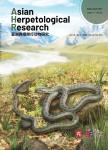Validation and Application of Skeletochronology for Age Determination of the Ryukyu Ground Gecko, Goniurosaurus kuroiwae(Squamata: Eublepharidae)
Validation and Application of Skeletochronology for Age Determination of the Ryukyu Ground Gecko, Goniurosaurus kuroiwae(Squamata: Eublepharidae)作者机构:Graduate School of Engineering and Science University of the Ryukyus Tropical Biosphere Research Center University of the Ryukyus
出 版 物:《Asian Herpetological Research》 (亚洲两栖爬行动物研究(英文版))
年 卷 期:2013年第4卷第4期
页 面:233-241页
核心收录:
学科分类:0710[理学-生物学] 07[理学] 071008[理学-发育生物学]
主 题:age structure endosteal resorption hatching line longevity rapprochement Ryukyu Archipelago
摘 要:Skeletochronology is a method commonly used for estimating the age of amphibians and reptiles in the wild. However, the number of lines of arrested growth (LAGs) does not necessarily reflect age in some species. We validated the applicability of this method to an endangered eublepharid gecko, Goniurosaurus kuroiwae, then inferred its longevity and age structures in wild populations. We classified young geckos into three groups using previously published data for early growth: Group 1 contained hatchlings before the first winter, Group 2 contained hatchlings after the first win- ter, and Group 3 included yearlings after the second winter. LAG numbers in these groups were then compared. All individuals in Group 1 possessed a single LAG, which was considered as a hatching line. Most individuals in Groups 2 and 3 possessed one and two additional LAGs, respectively (LAG1 and LAG2), corroborating the notion that LAGs are formed annually. A few geckos exhibited fewer LAGs than expected. Analysis of variations in LAG and marrow cavity diameter demonstrated that in animals with fewer LAGs, endosteal resorption or fusion of hatching line and LAG1 had occurred. LAG2 was never lost by endosteal resorption and was identifiable by its diameter. Thus, the age of adult geckos could be determined by counting LAGs outward from LAG2. Application of this method to wild populations re- vealed that the longevity of this species is not less than 83 months, but that almost all individuals in fragmented habitats die before 50 months, suggesting lower population sustainability in such habitats.



